We’re excited to introduce you to the always interesting and insightful Katie Mollon. We hope you’ll enjoy our conversation with Katie below.
Katie, appreciate you joining us today. Can you open up about a risk you’ve taken – what it was like taking that risk, why you took the risk and how it turned out?
I have always considered myself an experimental photographer. I use techniques such as in-camera multiple exposures, to create images that may or may not turn out how I imagine. Often times, the unpredictable elements of analog photography (such as light leaks), turn into happy accidents that enhance my vision. However, there was one technique I read about online, years before I worked up the nerve to try it. This process is commonly known as “film soup”. Film soup involves soaking your film in various substances/liquids before development. You can only guess as to how much of an effect each souped roll will have.
I entered the pandemic of 2020 having recently given birth to my second child. I found myself pushing the stroller around our same suburban neighborhood, day after day. I lost artistic inspiration from my surroundings. That’s when I remembered film soup – what would it hurt if I destroyed images I wasn’t that interested in, any way?
I became addicted to film soup after getting my first roll developed – and haven’t stopped trying new “recipes” since.


Katie, before we move on to more of these sorts of questions, can you take some time to bring our readers up to speed on you and what you do?
My name is Katie. I’ve been taking photos for as long as my parents would let me hold their camera. Visual art was always my passion. I went on to earn a Bachelor of Art degree in Photography. It was right around that time period that most people were switching from analog photography to digital. I was initially interested in switching to digital – as it seemed much more convenient as labs were closing down. I tried just about every photography gig imaginable.
However, in 2010 I got a job processing C-41 film. This reignited my passion for analog photography. As I shared images online, I got more and more questions from young people just discovering the medium. I also joined a group of like-minded artists called Film Shooters Collective. Through our site I am able to write articles, and curate photostreams, all dedicated to the art of film photography. I have also had opportunities here in the Detroit area to lead photo workshops, and mentor youth through photography.
I no longer have a day job related to photography. I have found that I prefer keeping my artistic life separated from earning income. This way I am able to completely focus on my own interests in my free time. I am never bored with photography, because I always have a list in my head of techniques to try.
My favorite thing about art and photography is how communal it can be. I love sharing my work with others, and hearing what meaning they assign to it. It has also been fun collaborating with writers and musicians to provide visual elements for their projects. Keeping dialogues going with fellow creatives is what keeps me inspired to make new work.


Learning and unlearning are both critical parts of growth – can you share a story of a time when you had to unlearn a lesson?
The biggest myth I had to unlearn about photography is that expensive gear equals better images. One of my first cameras was a cheap plastic medium format camera, called a Holga, that is essentially held together with tape. My university had a visiting artist, by the name of David Plowden, who makes incredible imagery of American landscapes. Of all of my images, he was most intrigued by the double-exposures taken with the Holga. And yet – I still had it in my head that I needed to be using a Hasselblad if I wanted to progress as a photographer.
Many digital SLR bodies and expensive lenses later – I make 90% of my work using the first two cameras I ever owned. You could purchase both of these cameras today for less than $100, total.
The camera or lens doesn’t make the photo. The person holding the camera – with all of their experiences and interests – creates the image.


Is there mission driving your creative journey?
Art has always been a way for me to learn about myself, and my connection to other people – as well as our connection to nature. Whenever my eye is drawn to a subject, I know there’s something to discover: what made it interesting to me? Do others see the same thing – or do they see something entirely different? Do they see it differently because of their different life experiences from my own? What can I learn from them?

Contact Info:
- Website: https://analogdreamer.onbokeh.com/
- Instagram: https://www.instagram.com/analoguedreamer/


